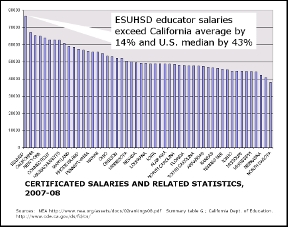Political Parties allow public school district officials to accept financial gifts from contracting government unions
2024
In California, it is routine for elected public officials to accept "gifts" from government contractors and then subsequently use their official position to vote to provide a target government benefit in return. Consider East Side Union High School District (ESUHSD) - the largest high school district in northern California.

ESUHSD board members - 2024
Example of how the corruption works
From 09/20/2020 to 10/17/2020, East Side Union High School District (ESUHSD) Trustee Pattie Cortese accepted $ 14081.05
from the East Side Teacher's Association (ESTA) that contracts with the school district. On 5/20/2021, Pattie Cortese then uses her official position to vote to award ESTA with a no-bid government contract.See Patti's "gifts" from ESTA.
See ESUHSD Board Meeting Minutes showing Patti's vote to approve the ESTA contract.
Sampling of documents showing ESUHSD elected Trustees accepting "gifts" from government contractors
| Elected Official | Gifts Amount | Source |
|---|---|---|
| Pattie Cortese | $ 14081.05 | Form 460 |
| $ 15000.00 | Form 460 | |
| $ 1000.00 | Form 497 | |
| $ 10079.82 | Form 460 | |
| $ 2000.00 | Form 460 | |
| $ 9879.82 | Form 460 | |
| Bryan Do | $ 12422.20 | Form 497 |
| $ 1659.84 | Form 497 | |
| $ 14081.04 | Form 497 | |
| Van Le | $ 400.00 | Form 460 |
| $ 400.00 | Form 460 | |
| $ 400.00 | Form 460 | |
| Lorena Chavez | $ 2400.00 | Form 460 |
| $ 4450.00 | Form 460 | |
| $ 1550.00 | Form 460 | |
| $ 2000.00 | Form 460 | |
| $ 2000.00 | Form 497 | |
| Manuel Herrera | $ 1900.00 | Form 460 |
| $ 1300.00 | Form 460 |
Elected officials receiving financial "gifts" from contractors inflates payments to the gifters and reduces service to the public. The
school board routinely accepts financial "gifts" from the teachers union and then in turn uses their official position to vote to
provide the teachers with uncharacteristic high compensation contract rates. The bulk of public school expenses is labor. Since
revenue for school districts is bascially equal throughout the State (Serrano vs. Priest), unequal labor contract rates
between districts results unequal staffing. School boards also perturb the step-column
pay scale so that the public is misled to believe that teachers are underpaid. Corruption allows
school boards to pay public school teachers more than medical doctors.
Corruption causes unequal public education for students - a violation of fundamental protected rights (Butt vs. California).
Complaints to the local District Attorney and State Attorney General have been ignored. It is believed that board members and others in local government are well connected to the same political party as those who are supposed to enforce the law. See "Political Parties recognized to be harmful to society".
Corruption causes unequal public education for students - a violation of fundamental protected rights (Butt vs. California).
Complaints to the local District Attorney and State Attorney General have been ignored. It is believed that board members and others in local government are well connected to the same political party as those who are supposed to enforce the law. See "Political Parties recognized to be harmful to society".

In 2007, ESUHSD compensation was comparatively high. As a result, staffing was inadequate resulting in a dropout rate of approximately 20%. Corruption by public officials denies youth the equal footing that public education is intended to provide. Click to see larger image.
Author's notes:
1 The author considers corruption by elected officials as accepting a "gift" and then voting to provide a targeted government benefit in return to those who provided the gift.
2 Nowadays, there is no good reason for candidates to accept "gifts" from anyone - the internet provides a virtually free medium for candidates to express their own election platform.
3 This writing is intended to be considered opinion protected under the First Amendment. The author intends to outline the facts making it clear that the challenged statements represent the author's own interpretation of those facts and leaving the reader free to draw his own conclusions. Partington v. Bugliosi, 56 F.3d 1147, 1156-57 (9th Cir. 1995).
1 The author considers corruption by elected officials as accepting a "gift" and then voting to provide a targeted government benefit in return to those who provided the gift.
2 Nowadays, there is no good reason for candidates to accept "gifts" from anyone - the internet provides a virtually free medium for candidates to express their own election platform.
3 This writing is intended to be considered opinion protected under the First Amendment. The author intends to outline the facts making it clear that the challenged statements represent the author's own interpretation of those facts and leaving the reader free to draw his own conclusions. Partington v. Bugliosi, 56 F.3d 1147, 1156-57 (9th Cir. 1995).